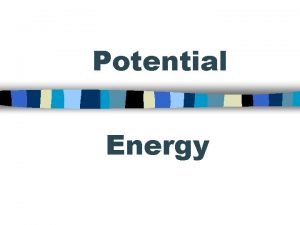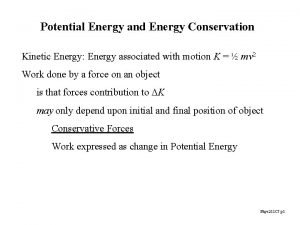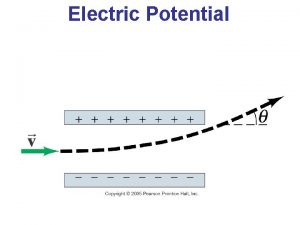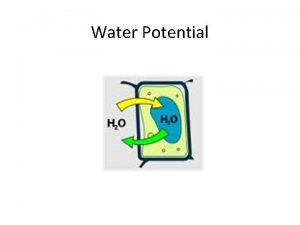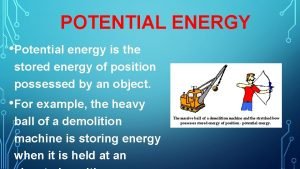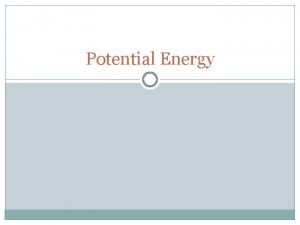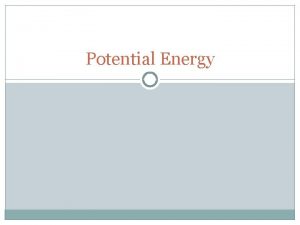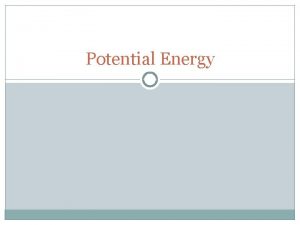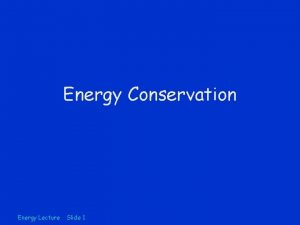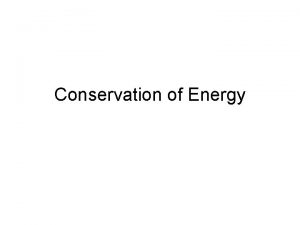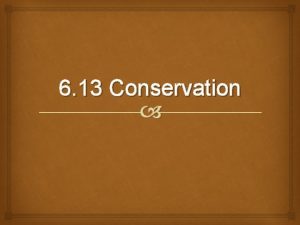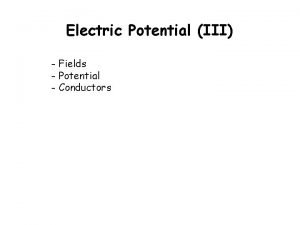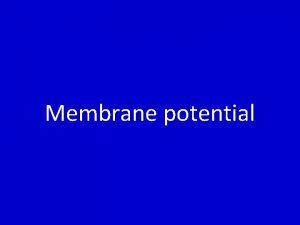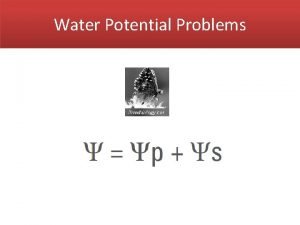7 Conservation of Energy Potential Energy The Conservation

























- Slides: 25

7 Conservation of Energy • • Potential Energy The Conservation of Mechanical Energy The Conservation of Energy Mass and Energy • Hk: 23, 27, 39, 47, 55, 69, 71

Potential Energy • Potential Energy is stored energy • Potential Energy is position dependent (KE is speed dependent) • Ex. object at higher height has more PE • Types of PE: gravitational, elastic, electric, magnetic, chemical, nuclear. • /

Conservative Forces • When the work done by a force moving from position 1 to 2 is independent of the path, the force is Conservative. • The work done by a Conservative Force is zero for any closed path. • Conservative Forces have associated Potential Energies • /

Non Conservative Forces • Produce thermal energy, e. g. friction • Work done by Non Conservative Forces is path dependent, e. g. longer path, more work required • /

Potential Energy Functions

Elastic Potential Energy

Ex. Elastic Potential Energy • • 100 N/m spring is compressed 0. 2 m. F = -kx = -(100 N/m)(0. 2 m) = -20 N U = ½kx 2 = ½(100 N/m)(0. 2 m)2 = 2 J /

Gravitational Potential Energy

Ex. Gravitational Potential Energy • Ex: A 2 kg object experiences weight (2 kg)(9. 8 N/kg) = 19. 6 N. • At 3 m above the floor it has a stored energy of mgy: • (2 kg)(9. 8 N/kg)(3 m) = 48. 8 Nm = 48. 8 J. • /

Conservation of Energy • Individual energy levels change. • Sum of all individual energies is constant. • /

Conservation of Mechanical Energy


Ex. Conservation of Mechanical Energy: Object dropped from height h above floor.

Energy E 1 E 2 E 3 Kinetic 0 ½mv 22 0 PE-g 0 0 mgh PEspring ½kx 2 0 0 Totals ½kx 2 ½mv 22 mgh

Energy Kinetic PE-g Totals E(h) E(y) 0 ½mv 2 mgh mgy mgh ½mv 2 + mgy Energies and speeds are same at height y Accelerations at y are not same

Work Energy with Friction

Example: The smaller the frictional force fk, the larger the distance, s, it will travel before stopping. s Energy Ei Ef Kinetic ½mvi 2 0 PE-g 0 0 Thermal 0 fks Totals ½mvi 2 fk s

A 2. 00 kg ball is dropped from rest from a height of 1. 0 m above the floor. The ball rebounds to a height of 0. 500 m. A movieframe type diagram of the motion is shown below. Type E 1 E 2 E 3 E 4 E 5 gravita mg(1) -tional 0 0 0 mg(1/2) kinetic 0 ½ m(v 2)2 0 ½ m(v 4)2 0 elastic 0 0 PEelastic 0 0 therma 0 l 0 Ethermal

By energy conservation, the sum of all energies in each column is the same, = E 1 = mg(1) = 19. 6 J Calculate v 2: (use 1 st and 2 nd columns) mg(1) = ½ m(v 2)2. g = ½ (v 2)2. v 2 = 4. 43 m/s Calculate PE-thermal: (use 1 st and 5 th columns) mg(1) = mg(1/2) + PE-thermal mg(1/2) = PE-thermal = 9. 8 J

Calculate PE-elastic: (use 1 st and 3 rd columns) PE-elastic + PE-thermal = mg(1) PE-elastic + 9. 8 = 19. 6 PE-elastic = 9. 8 J Calculate v 4: (use 1 st and 4 th columns) ½ m(v 4)2 + PE-thermal = mg(1) ½ m(v 4)2 + 9. 8 = 19. 6 ½ m(v 4)2 = 9. 8 (v 4)2 = 2(9. 8)/2 v 4 = 3. 13 m/s

Potential Energy & Force

Equilibrium • Stable: small displacement in any direction results in a restoring force toward Equilibrium Point • Unstable: small displacement in any direction results in a force away from Equilibrium Point • Neutral: small displacement in any direction results in zero force

Mass and Energy

Efficiency & Thermodynamics

Summary • • • Potential Energy function & force The Conservation of Mechanical Energy The Conservation of Energy Mass and Energy /
 Units of electric potential energy
Units of electric potential energy Electric potential
Electric potential V=pe/q
V=pe/q Chapter 7 energy conservation of energy
Chapter 7 energy conservation of energy Formula for energy
Formula for energy Gravity kinetic energy
Gravity kinetic energy Chemical potential energy examples pictures
Chemical potential energy examples pictures What is an example of mechanical energy
What is an example of mechanical energy Gravitational potential energy vs kinetic energy
Gravitational potential energy vs kinetic energy The law of conservation of energy states that
The law of conservation of energy states that Potential energy examples pictures
Potential energy examples pictures Types of potential energy
Types of potential energy Potential energy
Potential energy Conservation of mechanical energy
Conservation of mechanical energy Osmotic potential vs water potential
Osmotic potential vs water potential Flaccid turgid and plasmolysis
Flaccid turgid and plasmolysis Water potential equation
Water potential equation Neuronal pool
Neuronal pool Graded potentials
Graded potentials Graded potential
Graded potential Action potential definition
Action potential definition Graded potential vs action potential
Graded potential vs action potential Osmotic potential vs water potential
Osmotic potential vs water potential Action potential resting potential
Action potential resting potential End-plate potential vs action potential
End-plate potential vs action potential Rocuronium dose
Rocuronium dose



























